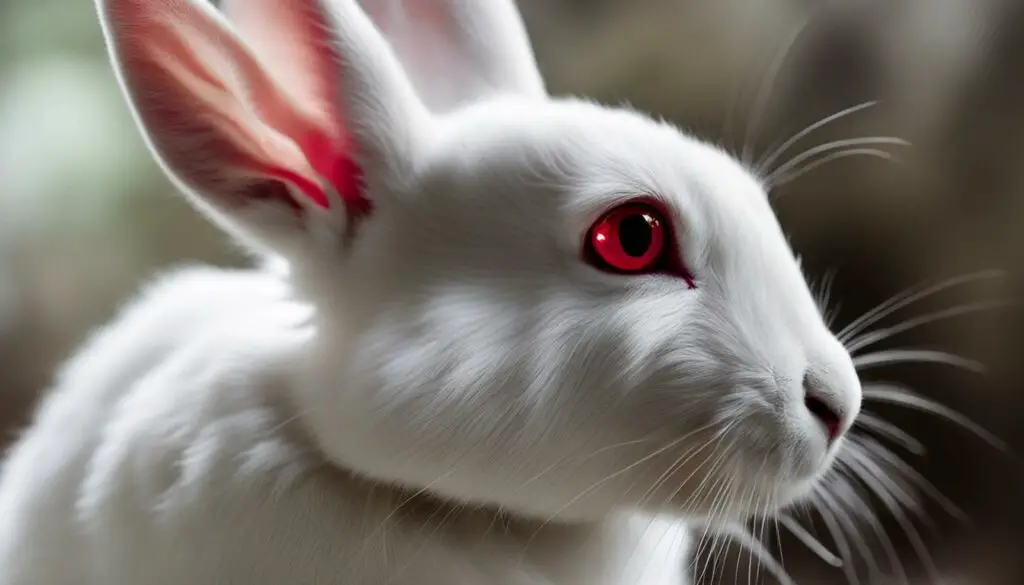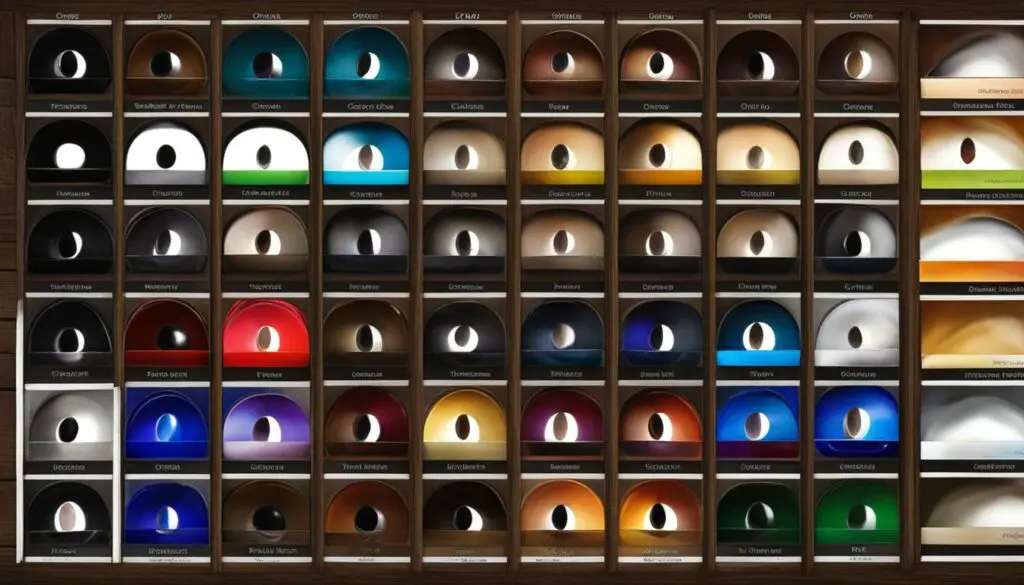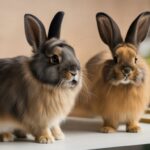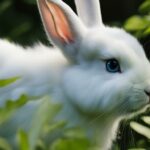Greetings! I’m excited to delve into the world of rabbit eye color with you. As an animal lover and researcher, I find it fascinating how these beautiful creatures exhibit such a wide range of eye colors. In this study, we will explore the genetic basis of rabbit eye color, uncovering the intricate mechanisms and variations that exist within different breeds.
Key Takeaways:
- Rabbit eye color is determined by genetic factors.
- There is a wide variety of eye colors within different rabbit breeds.
- The domestication process and selective breeding have contributed to the genetic diversity in rabbit eye color.
- Coat color genes play a significant role in determining eye color variations in rabbits.
- Understanding the genetics and inheritance patterns can assist breeders in producing rabbits with desired eye colors.
The Domestication Process of the Rabbit and the Origin of the Genetic Diversity in this Species
The domestication of rabbits began with the capture and breeding of wild forms. The two subspecies of wild European rabbits, O. c. algirus and O. c. cuniculus, have different genetic characteristics due to their separate evolution. The domestication process mainly relied on the O. c. cuniculus subspecies found in France, which eventually led to the establishment of different rabbit breeds. The breeds exhibit genetic differentiation and have been selected for specific exterior traits, including coat color, which plays a role in determining eye color.

Through selective breeding, breeders have fixed naturally occurring mutations to create distinct lines and breeds with unique eye color variations. The inheritance of eye color in rabbits is complex and can involve multiple genes. Understanding the genetics behind eye color inheritance can help breeders produce desired eye colors in their rabbits.
The Evolution of Rabbit Breeds
| Rabbit Breed | Origin | Distinctive Traits |
|---|---|---|
| English Angora | England | Long, silky fur and gentle temperament |
| Dutch | Netherlands | Tri-color pattern and compact body |
| Flemish Giant | Belgium | Large size and friendly disposition |
“The domestication of rabbits has led to the development of various breeds with unique traits. Selective breeding has allowed breeders to create rabbits with specific eye colors, adding to the overall diversity within the species.” – Rabbit Breeder
The genetic diversity and evolution of rabbit eye color reflect the rich history of rabbit breeding and human interaction with this species. Eye color variations have aesthetic appeal and contribute to the overall attractiveness of a rabbit, while also serving as indicators of certain health conditions or genetic traits. Studying eye color variations in rabbits provides valuable insights into the underlying genetic mechanisms and potential health implications. In the next sections, we will delve deeper into the molecular characterization of coat color affecting genes, rabbit vision, and the implications of eye color variations in rabbit breeds.
Molecular Characterization of Coat Color Affecting Genes in Rabbits
Rabbits exhibit a wide range of coat colors, and these variations are determined by genetic factors. The molecular characterization of coat color affecting genes in rabbits has provided valuable insights into the biology of pigmentation in mammals. Through extensive research, scientists have identified specific genes responsible for coat color variations and the mutations that lead to different eye colors in rabbits.
One of the key genes involved in rabbit coat color is the melanocortin 1 receptor (MC1R) gene. This gene plays a crucial role in determining the distribution of pigment-producing cells, known as melanocytes, in the skin and hair follicles. Mutations in the MC1R gene can result in a range of coat colors, including black, brown, or even red. In some cases, these mutations can also affect the pigmentation of the eyes, leading to variations in eye color among different rabbit breeds.
| Coat Color | Gene | Mutation | Eye Color |
|---|---|---|---|
| Black | MC1R | Wild type (no mutations) | Dark brown or black |
| Chocolate | MC1R | Mutation in MC1R gene | Varying shades of brown |
| White | MC1R | Mutation in MC1R gene | Can range from blue to pink |
In addition to the MC1R gene, other genes such as the Agouti signaling protein (ASIP) gene and the Extension (E) gene also play a role in determining coat color and eye color in rabbits. These genes interact with the MC1R gene and influence the production and distribution of pigments in the hair and eyes. The combinations of different gene variants and mutations can result in a wide variety of coat colors, patterns, and eye colors among rabbit breeds.
Studying the molecular characterization of coat color affecting genes in rabbits not only provides valuable insights into the genetics of pigmentation but also has practical implications for breeders and enthusiasts. Breeders can utilize this knowledge to selectively breed for specific coat colors and eye colors in their rabbits, resulting in the creation of unique and desirable breeds. Additionally, understanding the genetic basis of coat color and eye color variations can aid in the identification of potential health conditions or genetic traits in rabbits, contributing to their overall well-being and care.
Rabbit Vision: Unique Adaptations and Color Perception
When it comes to vision, rabbits have unique adaptations that help them navigate their environment as prey animals. Their eyes are positioned on the sides of their heads, providing a wide field of view of 360 degrees, allowing them to detect approaching predators from various directions. However, this wide field of view also means that rabbits have a blind spot directly in front of their nose. This blind spot is compensated by their ability to rotate their heads quickly, allowing them to scan their surroundings and identify potential threats.
Rabbits have an interesting visual perception that differs from humans. Their vision is primarily geared towards detecting movement rather than focusing on fine details or depth perception. They have two-dimensional vision, meaning that they struggle with perceiving depth accurately. However, their visual acuity allows them to distinguish different shades of colors, particularly greens and blues, as their natural diet consists of green vegetation. This color perception is essential for them to identify different types of plants and distinguish between edible and non-edible vegetation.
It’s important to note that rabbits rely on their other senses, such as their highly developed sense of smell and acute hearing, to complement their vision. These senses provide them with additional information about their surroundings, helping them accurately perceive and navigate their environment.
Rabbit Eye Structure
The unique eye structure of rabbits contributes to their specialized vision. Rabbits have large, protruding eyes that are positioned on the sides of their heads. This placement allows for a wider peripheral vision, enhancing their ability to detect potential predators. The position of their eyes also provides a panoramic view, giving them a broad field of vision without the need for head movement. However, this eye placement results in a limited ability to focus on objects directly in front of them, as their binocular vision is limited.
Another notable feature of rabbit eyes is their prominent nictitating membrane, also known as the third eyelid. This transparent membrane helps protect their eyes from dust, debris, and bright light. It acts as a natural shield, keeping the eyes moist and providing additional protection against potential harm.
Understanding Color Perception in Rabbits
While rabbits have the ability to perceive and distinguish colors, their color vision is not as developed as that of humans. Their visual system is more sensitive to certain wavelengths of light, particularly greens and blues. This is because their natural habitat consists of grasses and other vegetation, which predominantly reflect green light. As a result, rabbits are well-equipped to detect variations in shades of green, which is essential for foraging and identifying suitable food sources.
It’s interesting to note that rabbits have a limited ability to perceive reds and oranges, as their vision is less sensitive in the longer wavelength spectrum. This is why red or orange objects may appear dull or less vibrant to rabbits. However, they can still perceive differences in brightness and contrast, allowing them to navigate their environment effectively.
| Color Perception in Rabbits | Key Points |
|---|---|
| Primary Colors | Rabbits perceive greens and blues more accurately than reds and oranges. |
| Shades and Tints | Rabbits can distinguish different shades and tints of greens and blues, allowing them to identify subtle variations in their surroundings. |
| Contrast and Brightness | Rabbits rely on contrast and brightness to navigate their environment and identify potential threats. |
| Environmental Adaptation | Rabbit color perception has evolved to suit their natural habitat, where green vegetation dominates. |
Eye Scanning in Rabbits: Exploring a Curious Behavior
Rabbits are known for their unique behaviors, and one of the most fascinating is eye scanning. This behavior, commonly observed in rabbits, involves the rabbit weaving and bobbing its head to get a better look at something. Eye scanning is particularly prevalent in red eye white (REW) rabbits, but it can also occur in rabbits with other eye colors.
So what exactly is the purpose of eye scanning? It is believed that this behavior helps rabbits gather more information about their environment and gauge their surroundings. When a rabbit is unsure or curious about something nearby, it will engage in eye scanning to get a better understanding of what is happening around it.
While eye scanning is more commonly seen in REW rabbits, it is not exclusive to them. Rabbits with other eye colors may also exhibit this behavior, although perhaps to a lesser extent. Eye scanning showcases the natural curiosity and alertness of rabbits, as they are constantly on the lookout for potential threats or changes in their surroundings.
The Role of Eye Scanning in Rabbit Communication
Eye scanning is not only a way for rabbits to gather information; it can also serve as a form of communication. For example, a dominant rabbit may engage in eye scanning as a way to assert its dominance over other rabbits in its territory. By scanning its surroundings, the dominant rabbit is sending a clear message that it is aware and in control.
Additionally, eye scanning can be a sign of curiosity or interest. When a rabbit encounters something new or unfamiliar, it may engage in eye scanning to examine it more closely. This behavior allows rabbits to explore and understand their environment, ensuring they are always aware of any changes or potential dangers.
| Eye Scanning Behavior in Rabbits | Implications |
|---|---|
| Commonly observed in red eye white (REW) rabbits | REW rabbits may exhibit higher levels of curiosity and alertness |
| Can occur in rabbits with other eye colors | Eye scanning is not exclusive to REW rabbits and can be seen in rabbits with various eye colors |
| Can serve as a form of communication | Eye scanning can be used by dominant rabbits to assert their dominance or express curiosity |
In conclusion, eye scanning is a curious behavior observed in rabbits, particularly in red eye white rabbits. It allows rabbits to gather information, communicate, and explore their surroundings. Understanding this behavior can provide valuable insights into rabbit behavior and help us better understand and care for these fascinating animals.

The Genetics of Red and Pink Eyes in Rabbits
The red or pink eyes seen in some rabbits are a result of albinism, a condition characterized by the complete lack of pigmentation. Albinism has been intentionally bred into certain rabbit bloodlines to produce all-white rabbits with red or pink eyes. The trait is recessive and can be passed down by carriers of the recessive gene. Albinos are sensitive to sunlight due to their lack of pigmentation and may seek shade to protect their sensitive eyes.
Albinism in rabbits is associated with a mutation in the gene coding for tyrosinase, an enzyme essential for the production of melanin, the pigment responsible for coloration in skin, hair, and eyes. The mutated gene prevents the production of melanin, resulting in the characteristic red or pink eye color seen in albino rabbits. Without melanin to absorb light, the blood vessels in the rabbit’s eyes become visible, giving them their unique appearance.
While red or pink eyes are commonly associated with albinism, it’s important to note that not all rabbits with red or pink eyes are albinos. Some rabbits, particularly those with lighter coat colors, may have pink or light-colored eyes due to a higher concentration of blood vessels in the ocular tissues. These rabbits may have normal pigmentation but display a different eye color, making it essential to distinguish between true albinos and rabbits with other eye color variations.

Table: Comparison of Albino and Non-Albino Rabbit Eye Colors
| Eye Color | Description |
|---|---|
| Red or Pink | Characteristic eye color of albino rabbits due to the absence of melanin pigment. |
| Blue | Light blue or grayish-blue eye color seen in some non-albino rabbits with lighter coat colors. |
| Brown | Common eye color in non-albino rabbits, ranging from light to dark shades of brown. |
| Hazel or Amber | Less common eye colors seen in some non-albino rabbits, often associated with specific coat colors or patterns. |
In the world of rabbit breeding, eye color is an important trait that contributes to the overall appearance and appeal of different breeds. Understanding the genetics behind red and pink eyes in rabbits not only sheds light on the underlying mechanisms of pigmentation but also helps breeders produce desired eye colors in their breeding programs. Whether it’s the striking red eyes of albinos or the subtle variations in eye color seen in non-albino rabbits, eye color adds to the fascinating diversity and beauty of these beloved animals.
Historical Overview of Rabbit Eye Color and Genetic Differentiation
Throughout history, rabbit eye color has evolved and diversified due to the domestication process and selective breeding. The fixation of different coat color genes has led to genetic differentiation between breeds, resulting in the wide range of eye colors seen today. Let’s take a closer look at the historical development of rabbit eye color and the genetic factors that contribute to its variations.
Dating back to the domestication of rabbits, breeders selectively bred for specific coat colors, which influenced eye color variations. As different breeds were established, distinct eye colors became defining traits for each breed. This fixation of coat color genes resulted in genetic differentiation between breeds, creating a diverse array of eye colors across the rabbit population.
“The history of rabbit eye color reflects the rich history of rabbit breeding and human interaction with this species.” – Rabbit Breeders Association
| Breed | Eye Color |
|---|---|
| Dutch | Blue |
| English Spot | Hazel |
| Rex | Red |
| Flemish Giant | Brown |
Table: Eye colors associated with different rabbit breeds.
This historical overview not only sheds light on the evolution of rabbit eye color but also highlights the immense genetic diversity within the species. The interplay between humans and rabbits throughout the centuries has shaped the variety of eye colors we see today. By understanding the historical context of rabbit eye color, we can appreciate the intricate genetic mechanisms that contribute to this fascinating aspect of rabbit breeding and genetics.
The Role of Selective Breeding in Eye Color Variation
Selective breeding has played a significant role in creating the wide range of eye colors seen in rabbit breeds. Breeders have carefully chosen specific rabbits with desired eye colors and bred them together to produce offspring with similar traits. This process has allowed breeders to fix naturally occurring mutations that affect eye color, resulting in distinct lines and breeds with unique variations.
Eye color inheritance in rabbits is complex and can involve multiple genes. Different coat color genes, as well as other genetic factors, contribute to determining eye color. For example, the presence or absence of certain pigments can influence whether a rabbit’s eyes appear blue, brown, or another color. By selectively breeding rabbits with specific coat colors and patterns, breeders can indirectly influence the expression of eye color.
In addition to genetics, environmental factors can also impact eye color expression in rabbits. Sunlight exposure, diet, and habitat conditions can all influence the appearance and intensity of eye color. For example, rabbits exposed to excessive sunlight may experience fading or darkening of their eye color over time. Breeders and rabbit enthusiasts should take these factors into consideration when evaluating and breeding for specific eye colors.
| Factors Affecting Eye Color Variation | Contributing Factors |
|---|---|
| Genetics | Multiple genes, coat color genes, pigmentation factors |
| Selective Breeding | Fixation of naturally occurring mutations |
| Environmental Factors | Sunlight exposure, diet, habitat conditions |
Understanding the role of selective breeding and environmental factors in eye color variation is crucial for breeders looking to produce rabbits with specific eye colors. By carefully selecting and pairing rabbits with desired traits, breeders can continue to create new and unique eye color variations in rabbit breeds.

Implications of Eye Color Variations in Rabbit Breeds
Eye color variations in rabbit breeds contribute to the overall phenotypic diversity of these captivating animals. Different breeds showcase a wide range of eye colors, from deep blues to vibrant greens and rich browns. The unique eye colors in rabbits not only add to their aesthetic appeal but also serve as defining traits for specific breeds.
For breeders and enthusiasts, eye color variations play a crucial role in selecting and pairing rabbits for breeding programs. The eye color chart serves as a valuable tool for identifying and describing different eye colors, aiding breeders in producing rabbits with desired traits. By understanding the genetic mechanisms behind eye color inheritance, breeders can predict and manipulate eye color outcomes in their breeding programs.

Eye color can also provide insights into certain health conditions or genetic traits in rabbits. For example, red or pink eyes in rabbits are a result of albinism, a condition characterized by the complete lack of pigmentation. Albinos are sensitive to sunlight and seek shade to protect their eyes. Monitoring eye color can help breeders identify and address potential health concerns in their rabbits.
The study of eye color variations in rabbit breeds not only enhances our understanding of the genetic diversity within the species but also showcases the remarkable phenotypic diversity in rabbits. As breeders continue to explore the genetics and inheritance patterns of eye color, they contribute to the preservation and development of unique eye colors, further enriching the rabbit breeding community.
Rabbit Eye Color Chart: A Visual Reference for Breeders
As a rabbit breeder, having a comprehensive understanding of eye color variations is essential for selecting and pairing rabbits with desired traits. A rabbit eye color chart serves as a valuable visual reference, categorizing different eye colors and providing breeders with a standardized way of describing and identifying eye colors in their rabbits.

The rabbit eye color chart showcases the wide range of eye colors seen across different breeds, allowing breeders to easily compare and contrast variations. It helps in identifying specific eye color genes and determining how they contribute to the overall appearance of rabbits. By utilizing the eye color chart, breeders can make informed decisions when planning their breeding programs.
Breeders can use the chart to select rabbits with specific eye colors and pair them with compatible partners to produce offspring with the desired eye color. It also aids in identifying eye color variations within specific breeds and understanding which genes are responsible for specific eye colors. The eye color chart provides a visual representation of the genetic diversity and inheritance patterns associated with eye color in rabbits.
Rabbit Eye Color Genetics: A Complex Interplay of Genes
The genetics of rabbit eye color is a fascinating and intricate subject. It involves a complex interplay of multiple genes that contribute to the wide range of eye color variations seen in different breeds. Understanding the inheritance patterns and genetic mechanisms behind rabbit eye color is crucial for breeders who wish to produce rabbits with desired eye colors.
Genes and Eye Color Inheritance
Eye color in rabbits is influenced by various coat color genes as well as other genetic factors that regulate pigmentation. Different breeds exhibit specific combinations of genes that contribute to their unique eye color variations. The inheritance patterns of eye color in rabbits can follow Mendelian inheritance, where the expression of eye color is determined by dominant and recessive alleles, or involve more complex genetic interactions.
Selective breeding has played a significant role in the creation of different eye colors in rabbits. Breeders have selectively bred rabbits with specific coat colors and patterns, which are often linked to certain eye colors. By fixing naturally occurring mutations through breeding, breeders have been able to create distinct lines and breeds with unique eye color variations.
Environmental Factors and Eye Color
In addition to genetics, environmental factors can also influence the expression of eye color in rabbits. Factors such as diet, habitat, and exposure to sunlight can affect the intensity and appearance of eye color. For example, sunlight exposure may cause fading or darkening of eye color in certain rabbits. Understanding the interplay between genetics and environmental factors can help breeders and enthusiasts evaluate and breed for specific eye colors more effectively.
Conclusion
The genetics of rabbit eye color is a complex and fascinating field of study. It involves the interplay of multiple genes and factors that contribute to the wide range of eye color variations seen in different breeds. Understanding the genetics and inheritance patterns of eye color can assist breeders in predicting and manipulating eye color outcomes in their breeding programs. Additionally, considering environmental factors can help breeders evaluate and breed for specific eye colors more effectively. By delving into the genetics of rabbit eye color, we gain valuable insights into the underlying mechanisms of pigmentation in mammals.
Environmental Factors and Eye Color Expression in Rabbits
When it comes to the eye color of rabbits, genetics is the primary determining factor. However, environmental factors can also play a role in the expression of eye color. Factors such as diet, habitat, and exposure to sunlight can influence the intensity and appearance of eye color in rabbits.
Rabbits that are exposed to a diet rich in certain pigments may have more vibrant and intense eye colors. For example, a diet high in leafy green vegetables can enhance the green hues in a rabbit’s eyes. On the other hand, rabbits that are deficient in certain nutrients may have duller eye colors.
“The diet and habitat of a rabbit can influence the appearance of their eye color.”
Exposure to sunlight can also affect the expression of eye color in rabbits. Sunlight contains ultraviolet (UV) radiation, which can cause the fading or darkening of pigments in the eyes. This is particularly noticeable in rabbits with lighter eye colors, such as blue or gray. Overexposure to sunlight can result in the bleaching of pigments, leading to a lighter eye color.
Considering these environmental factors is important for breeders and rabbit enthusiasts who are interested in maintaining and enhancing specific eye colors in their rabbits. By providing a well-balanced diet and proper habitat conditions, breeders can help ensure that the desired eye colors are expressed to their fullest potential.

Table: Factors Affecting Eye Color Expression in Rabbits
| Environmental Factor | Effect on Eye Color Expression |
|---|---|
| Diet | Affects pigment availability and intensity |
| Habitat | Can influence overall health and pigmentation |
| Exposure to Sunlight | May cause fading or darkening of eye color |
Understanding the interplay between genetics and environmental factors in eye color expression can contribute to the overall health and well-being of rabbits. By carefully managing these factors, breeders and enthusiasts can help ensure that their rabbits not only have striking eye colors but also exhibit optimal pigmentation and overall vitality.
Conclusion
In conclusion, the study of rabbit eye color has provided fascinating insights into the genetic diversity and variations within different breeds. Through careful examination of the genetics behind rabbit eye color, we have discovered the complex interplay of genes that determine eye color outcomes. By understanding the inheritance patterns and environmental factors influencing eye color expression, breeders can produce rabbits with desired eye colors.
Selective breeding has played a significant role in the creation of the wide range of eye colors seen in rabbits today. Fancy breeders have utilized specific coat colors and patterns to selectively breed for unique eye color variations. This has led to the development of distinct lines and breeds with eye colors that are valued as defining traits within each breed.
From a scientific standpoint, studying rabbit eye color not only adds to the aesthetic appeal of these animals, but also provides valuable insights into the genetic mechanisms underlying pigmentation in mammals. The comprehensive understanding of rabbit eye color genetics can aid breeders in predicting and manipulating eye color outcomes in their breeding programs. Additionally, eye color variations can serve as indicators of certain health conditions or genetic traits in rabbits.
Overall, the study of rabbit eye color has shed light on the fascinating world of genetics and phenotypic diversity in this versatile domestic species. As we continue to explore the genetic basis of eye color and the variations that exist within different breeds, we gain a deeper appreciation for the intricate interplay of genes that shape the visual beauty of these remarkable creatures.
FAQ
What determines the eye color in rabbits?
Eye color in rabbits is determined by various genes that affect pigmentation.
How do different breeds of rabbits have different eye colors?
Different breeds of rabbits have been selectively bred for specific coat colors and patterns, which influence eye color variations.
How can I predict and manipulate eye color in my rabbits?
Understanding the genetics and inheritance patterns of eye color in rabbits can help breeders produce desired eye colors through selective breeding.
Do environmental factors affect rabbit eye color?
Yes, factors such as diet, habitat, and sunlight exposure can influence the expression and intensity of eye color in rabbits.
Can rabbits with different eye colors see differently?
Rabbits primarily see in greens and blues, and their vision is primarily geared towards detecting movement. Eye color variations do not significantly affect their visual abilities.
Are red and pink eyes in rabbits a result of albinism?
Yes, red and pink eyes in rabbits are a result of albinism, a condition characterized by the complete lack of pigmentation.
How can I use a rabbit eye color chart in my breeding program?
A rabbit eye color chart serves as a visual reference for breeders to select and pair rabbits with desired eye colors for breeding programs.
What is the genetic basis of rabbit eye color?
Eye color in rabbits is determined by a complex interplay of multiple genes, with coat color genes and other genetic factors regulating pigmentation.
Can eye scanning in rabbits indicate something about their health or behavior?
Eye scanning in rabbits is a behavior commonly observed in certain breeds and can be an indicator of curiosity or uncertainty about the environment.








